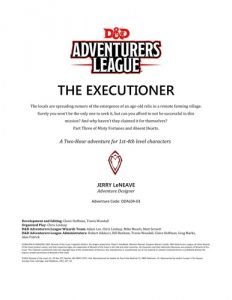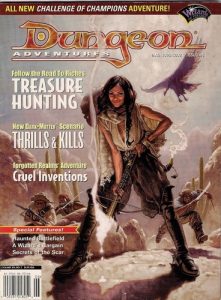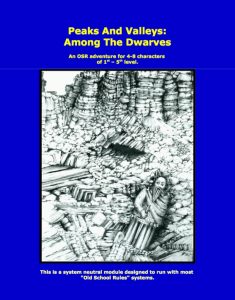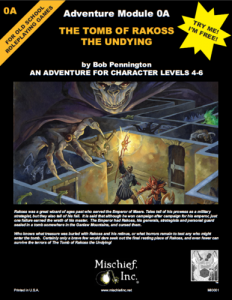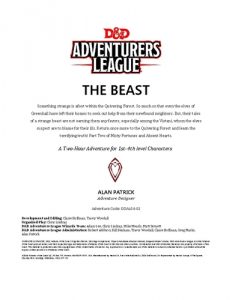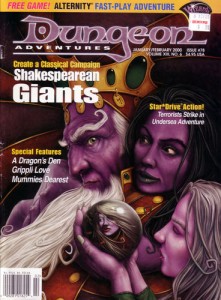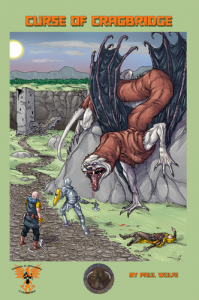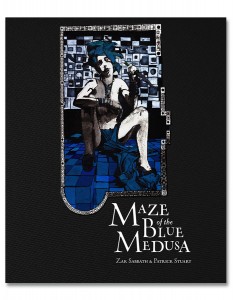
by Patrick Stuart & Zak Sabbath
Satyr Press
Fantasy RPG’s
Level: 1-4 if you’re smart. 5-10 if not.
Infinite broken night. Milky alien moons. Wavering demons of gold. Held in this jail of immortal threats are three perfect sisters…
Known then that it is the year 2016. The known universe is ruled by the DIY RPG. Future generations shall think themselves accursed they were not here and hold their manhoods cheap whiles any speaks they played Maze of the Blue Medusa.
Executive Summary:
The PDF is $5. It’s magnificent. This is the type of D&D I want to play. Go buy it.
This is a 304 room dungeon described over 144 pages. It houses a medusa “timeless eons old” who runs the place kind of like a prison, petrifying the worst of the worst. It’s not a maze, in the minotaur/labyrinth sense, but rather a large (304 rooms!) and complex map. Some of her friends live there. Some nut jobs are running around. It’s magnet for anyone and everyone who is interested in a timeless eons medusa and the threats she imprisons. This isn’t a hack piece where monsters attack when you enter the room. Some people are going to be turned off by the flavor of this. It’s not orcs in rooms. If you can handle Planescape then you can handle Maze of the Blue Medusa. And you should. It’s one of the best adventures ever produced, ranking among the best both in creative content and usability.
In the forward there’s a short note from the publisher. He notes that games can contain art & writing better than most of the work spat out from the big four publishers or hung up in Soho. Clearly referring to his own publishing industry, the existence of a work like Maze of the Blue Medusa makes one wonder about the big publishers in our own little niche. The dreck keeps rolling out from the big names doing work for the big RPG publishers. I have no idea why people tolerate it. The blathering platitudes of the fanboys shouting THANK YOU SIR PLEASE SIR MAY I HAVE ANOTHER (Princes of the Apocalypse sits with a rating of 90% at ENWorld.) gives one pause. And then something like Maze of the Blue Medusa comes along and you can breathe again. I should retract that last statement. Nothing like Maze of the Blue Medusa has come along before.
Patrick has written a lot of great content on his blog as well as putting out the masterful Deep Carbon Observatory. DCO is one of my favorites of all time; a magnificent work of terseness and evocative language with wonderful situations centered around the players characters. Zak has published a couple of excellent gaming supplements and writes pretty insightful adventure commentary on his blog. His writings are spot on when it comes to adventure design. Will two great tastes taste great together? Of course. I already said they did. You did go buy this, right?
Forgive me while I stick my head up my own ass a bit before I get to the usual bits of reviewing. There are a couple of interesting things going on with this adventure that go beyond my usual review criteria. First, in relation to DCO, this is different. It shares the creativity and evocative language of DCO, but that’s about it. I think Patrick has published three things so far. Each has been very distinct from the others. That’s quite remarkable.
Second, the adventure has a different style. It’s make different assumptions. Most of the WOTC/TSR campaign settings are just D&D. High D&D. Low D&D. King D&D. Space D&D. A foray into CoC. And then there was Planescape. It was different, somehow. It made different assumptions, it had a different feel. Clearly on the same D&D spectrum but way down at the end of it. There’s an OSR game, Mazes & Minotaurs, I think? It does a bit of the same thing. Instead of Gygax/etc writing D&D based on LoTR and Appendix N, it presumes that instead that context did not exist and they made a fantasy RPG based around their love of Greek myths and legends. Maze of the Blue Medusa feels closer to that. There was this vibe in Caverns of Thracia where things felt a bit … older? A bit more mythic or inspired by things other than Appendix N. A little more classical, in reference to the greek. Maze of the Blue Medusa ramps that up. Where Thracia may have dipped it’s toes in then Medusa is some magnificent mash up of a classical vibe and the weirdness from Planescape and/or Vornheim. Mosaics come to life. Philosophers. Tragedy. Things come in threes. Three swords, three sisters, and so on. Creatures and NPC’s take on platonic qualities. “I do not age.” “All who see me love me.” and so on. It’s not similar to the classics because it has a medusa in it. It’s similar to the classics because of the themes and re use of the shared consciousness from those stories. This creates, I think, some kind of universal context that almost everyone can relate to. This may be a bit off putting to folks who want their standard orcs and standard ogres to fight their standard Wizards and stands dragonborn fighter in a standard set piece room. It appeals to a different kind of play, a kind of play that I find exciting and wonderful. A play centered around the imagination. Tower of the Stargazer had this, to a certain small degree. The Tower of Gygax con games and to a lesser extent the DCC “continuous play” games have this as well. A kind of raw purity that you then interact with, but not so much in the mechanical way that Standard D&D has become.
One more thing. This plays with format in the same way that the One Page Dungeons do, and in the same way Stonehell does. I’m big on things beings USABLE at the table. This means the product, in form + function (hey, I bought my sofa from Helmut at that store!), must help the DM run the adventure. The one page dungeons focus on that. Everything is on one page, the DM is never hunting. Stonehell does that also. A couple of pages of introduction for each level just to get you oriented and then everything including the map, on one page. These format are, I think, all trying to solve the problem with the DM having to take notes. You read the source material, in the case of Stonehell, and then the map and keyed entries, all on the same page, serve as your notes. They trigger you to remember what you read earlier in the more extensive couple of pages about the level. If you don’t get it all right then who cares? You’re the DM, it’ll be ok. Medusa tries a different formula to do something similar. Hmmm, actually, I might say it’s very similar to the Stonehell formula. There’s a big overall map, of course, but the sections of the dungeon are split up into little parts. Each little part has it’s own map. Two maps, actually, spread out over two facing pages. One map has pretty pictures on it, along with ONE sentences, usually short, describing the room. The second … Fuck fuck fuck. I’m getting ahead of myself. More on the maps later. For this section let me say that there’s a map, with notes, and a short key with a couple of sentences per room, on facing pages. The next couple of pages describes the keyed rooms in more detail. The intent is that you read the entre section once through and then actually run the adventure from the facing map/terse-key facing pages. IE: one page per section, just like Stonehell. But oh so much better than Stonehell in both form + function.
Ok, meta-gushing is over. Time for specific gushing. Again, my standard warning apply: I don’t think I do a good job reviewing good adventures. I’m too excited.
The language used to describe the various encounters, objects, and NPC’s is stunning. Longtime readers will recall that I think that the purpose of the adventure text, the actual language used, is to inspire the DM. One well crafted sentence can do more than pages of boring fact-based dreck in communicating the vibe and feel that the designer is going for. The most important tool the designer has is the DM. If the designer can communicate the swirling chaos of the idea in their head to the DM, effectively, then the DM can take it and run with it, expanding it, augmenting it. So many designers fail in this. I’m sure that in their head they have something great and wonderful swirling around … but they then fail to get it out of their head and on to the page in a way that communicates their idea to the DM. Not so Maze of the Blue Medusa! Here’s an example from the garden: Bad Statues: Everything is black. Flares and vines grow around and into black soapstone statues depicting the forgotten dead.” Wonderful! Even without reading the supplemental text I can picture the scene in my head and I immediately start to expand on it! The black light of dead stars! A mixture of the dead and black thriving plants. Shades of black. It’s great. Massive hearts molted with a pulsing green. Pathetic, unwary, mute and terribly dangerous, NO-FACE is a shambling and tendrilled beart that guards the pipes. Constant screaming laughter drifting through all of the surrounding rooms. These descriptions inspire. They make you WANT to run the room/adventure. They make you want to draw others in and have them experience them as well. “Soft cello music emanates from this room. It is the music of the Moon Man mourning his stolen sons.” You don’t need a thesaurus to write an impactful description.
The encounters proper are creative and full of potential energy. “Hiding in the darkness behind the fallen shelves is an ID pig.” That’s full of action! Characters poking about in a ruined scene, full of shadows and potential danger. A sudden bursting out of a squealing pig. One of the first rooms, available in the preview I believe, is the Starlit Stones. Shadows turn into pits in this room, allowing you to fall into the pit shadow cast from a fellow party member if you are unaware/not careful. It’s weird. It’s not explained WHY. It just IS. Zak & Patrick understand that you don’t need to understand the why’s, you just need to know enough to run the room. Room after room after room. Some one to interact with. Some thing to interact with. Something weird. Something mysterious. One of the great joys of an environment like this is the players having their characters mix and match what they find to overcome obstacles. Maybe they come up with some need, later on, to trap someone in a shadow, or sea someone away. Ta da! Goofy plan time! Let’s lure it to the pit room! Escher stairs, with gravity reorienting toward the door last opened. Line walking with consequences … and creatures nearby that know and lurk. How about tiny lilliputian toy machines committing crimes of war? No? How about “A curly-horned devil with a twisted blade. He paces back and forth on cloven feet, listening at the western door, waiting for his chance, whispering to the knife he holds: “Now ..? Wait … now?” Jesus! Can you imagine?!?! I mean, now that we’ve been infected with the idea seed you obviously CAN imagine. That’s the entire point. Potential. Energy. Interaction. The players are confronted with a situation. I don’t even think I have the words to describe it. (Maybe that’s why I have a problem describing good adventures?) It’s not that it’s in medias res. It’s something else. You WANT to know what’s going on. It lures you in. It does this time and time again. It’s magnificent.
I count 139 named individuals in this adventure to interact with. Not monsters. Essentially, every creature you meet has a name. Every one has a motivation, something they want, something they don’t’ want, and at least a modicum of a personality. One of the key difference between this adventure and most others, and what it shares with the best, is that you can interact with the creatures you meet. This is SO much more interesting than just getting attacked by everything. It adds roleplaying, and plotting, crosses and double-crosses, and maybe even make friends and allies.The creatures are in the keys, but also summarized in the rear for easy reference. That section is an excellent aid to playability, ease to use, ease to find what you need, and the creatures/NPC’s goals. Here’s one of the entries I’m fond of “Waerlga: Animated statue of a Vampire. Telepathic, but can’t move. Very well informed about crowned heads. Wants: Blood spread all over hi. Someone to turn the lights off. Does Not Want: To be destroyed. That’s wonderful! The interaction possibilities for the party are mind-boggling! You can ALWAYS resort to hacking someone, but to be offered other choices … wonderful! The stories I remember are the ones where the hero is talking to the creature, and outsmarts them, or takes advantage of them, or does them a boon. Besides, there’s NOTHING more delicious than tempting a party with a friendly NPC that has something they REALLY want. An anarchic wax golem wanting to overturn the power structures … but who is terrified of the consequences … or getting found out. Just about every creature in the “maze” a relationship, positive or negative, with at least one other entity. There is very little presumption of guilt or innocence in their descriptions. Just people, with people problems, who have wonderful things for you to steal, or problems and boons if you help them. While a lot of their goals intersect with the medusa, it is her pad after all and that’s why they are all there, it’s not a black and white situation. This extends to the medusa proper; she’s not necessarily evil. It’s not that simple In fact, she might be thought of as doing good, or, given your own proclivity for moral absolutism, maybe a corrupt cop. This NPC/monsters are truly one of the special parts of this adventure. The factions, the possibilities, it’s wonderful. Time and time again there could have been the temptation to tell us about these creatures. It’s evil. It’s frightful, etc. But they don’t do this. Instead they SHOW why the creature is horrid, or a moral, or super-intelligent. You the DM, and implicitly the players are left to draw their own conclusions and make their own judgements.
The map in this adventure is quite interesting, in the way the Stonehell maps were., from a functionality standpoint. A full page map shows a color inset of the rooms about to be described, along with a picture in each room that acts as a reminder as to what the encounter is. It’s also got a nice sentence in the room on the map that describes the encounter. “Divided monster” or “indecisive devil” or “fountain with trapped elemental.” This section, without the notes, is based on the original work of art Zak produced that the adventure then flowed from. The surrounding rooms, with their room numbers, are also shown along with their room number, albeit in a subdued grey. This gives you the context of what’s nearby. The facing page shows another version of the map section in question, closer to what one would expect a traditional supplement map to look like, along with a small inset showing this section relation to the greater section it’s a part of, and where it fits in the entire maze/dungeon. (Zones, with themes! A megadungeon requirement to be sure!) This same page has the one or two sentence summary of what the room is, along with a hyperlink to the full romo description. As I mentioned, earlier, this format is quite functional and essentially shortcuts the note taking and highlighting that marks most adventure prep. I’m hesitant to use the word “perfect”, but the format is pretty damn spot on for running a megadungeon, expanding and improving on what the one-age dungeons do, and on what Stonehell then expanded upon.
Let’s finish up with the PhaT L00T. We’ve all seen adventures with +1 swords and potions of healing. Not so here! The best way to describe it is that many objects in the adventure can do things. Some of those things are swords & armor. Others vary wildly. The shield Rex Absentia, bears a fierce heraldic lion. It only provides a bonus if you run away, and then the first attack on you misses. Looking closely, the lion on shield is actually waving goodbye. That’s great! Interesting, detailed but not overly so, an effect that’s not just a mechanical +1! That’s a pretty perfect magic item in Brycelandia. How about a sword that turns blood into wine? Or one that transfers thoughts between any plant creature cut? (Rest assured, there are LOTS of plants in the maze.) Magic that’s actually wondrous and magical! Imagine that! Beyond the ‘typical’ objects there are hosts of others. The Tears of Time can undo one event, with a chance of failure/disaster equal to the number of syllables in the request. Mechanically brilliant AND mythic. A wrench that makes machinery breakdown? A bag of gremlins. An oil that corrodes moving parts? A book called “Moving on with your life” that will end a negative effect suffered from the undead? The place is teeming with non-standard items and things the tears, objects that can be “reused” for effect. These are the sorts of things that Rulings not Rules revolve around. How can the characters exploit what they’ve found an/or their environment? It’s this type of play that ENGAGES the players. It’s this type of play that I luv Luv LUV.
Each element of Maze of the Blue Medusa is near perfect. And I dare hazard to say that the entire thing is greater still than the sum of its parts. One could quibble with a stinker here or there, like the giant snail encounter that seems more static than other encounters, but given the overall quantity of the quality that would be the epitome of gauche. There are a handful of products that rank among the best. Choosing among the best is hard. It would be foolish to ask “What is the best painting?” Zak and Patrick are both very creative and produce creative work outside the bounds of traditional RPG channels. Zak, in particular, is quite vocal about the DIY community. The best content in the last few years is coming out of the DIY community. This work is no journeyman’s. It’s result of two DIY masters coming together and collaborating on something blindingly brilliant. I’m struggling here. I’ve been fighting myself for hours. I’m fighting against saying this is the best thing ever produced. I’m suspicious of absolutist statements. I’m suspicious of my own feelings and in the dangers of conflating preference with best, and with the confusing addition of nostalgia to the mix.
Maze of the Blue Medusa is in some higher tier than The Best. I love the gonzo of ASE1. The love the vision of Deep Carbon Observatory. I love the childlike wonder of The Darkness Beneath: The Upper Caves. Maze of the Blue Medusa is right up there with those four products. It’s not just good. It’s doesn’t just rank with the best. It ranks with that very smaller group of three adventures that I love. It ranks with those adventures that are not just the best but with that small handful that tower over the rest of the field known as The Best. And so three becomes four. Team Lead? First among equals? The best? I don’t know. Best to not think of artificial labels Bryce. Of the over one-thousand adventures I’ve reviewed this is the best. And because I’m a weasel and hypocrite I’ll say it’s tied for best with those other three.
The PDF is $5. It’s got some hyperlinks in it. A more hyper-linked version is coming out soon. There’s a print book on the way which, I believe, is claimed will drool-worthy gorgeous. I can believe it. The preview can give you a good overview of the style of the product, the map layouts and “DM Notes” I referenced earlier, and so on. I believe it’s the first eighteen rooms. I’m not sure that’s the section I would choose. The first room, in particular, is one of the more challenging of the text. It could also be the case but the first room also faces the challenge of getting you oriented to the text/layout style and that the later rooms are easier to pick up because you are already oriented to the text. The escher stairs, the shadow pits, Lady Nine Bones and most of the NPC’s are, I think a little more representative of the work as a whole than that first room, in terms of ease of comprehension. I love the first room, it’s just not the easiest to grok.
You can find a preview at the publisher, Satyr Press: http://satyr.press/motbm-teaser.pdf
Oh, did I mention that one of the wanderers are the Chameleon Women? And they are armed with machetes? If I were a murder hobo and I ran in to a group of women armed with machetes in a dungeon I think I’d pee myself a little.
This is available on DriveThru.
https://www.drivethrurpg.com/product/195785/Maze-of-the-Blue-Medusa-o-Deluxe-PDF?affiliate_id=1892600

